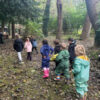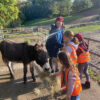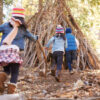
by Katie Harrison
Founder of Picture News
As our children grow, they become more aware of the world around them. Some events are sensitive and divisive, with global news often being unavoidable – including for children. Stories can be encountered online, on newspaper front pages, or via chatter in the playground. But what if the news didn’t have to be something to try to shield children from? As parents and carers, we can responsibly share current affairs with children, to equip them with tools to develop and learn from the world around them.
Make news discussions age-appropriate
Consider children’s age and developmental stage when planning your news discussions. You may wish to use visual content, including images and videos, but remember to vet these before sharing with children. For younger children, simplifying news events into relatable concepts, like being kind or unkind, fair or unfair can be effective. For older children, divulging more information can be appropriate. Reactions and understanding of news stories will differ for all children, but be confident that you know them best as you gauge how much information to share. News conversations can work well in the morning, to give children plenty of time to digest what’s happened, then reflect and share any questions or worries with you during the day.
Consider your role and influence
Be sure to observe and regulate your own reactions, language and behaviour when discussing news with children. As parents, we know children can be impressionable, and therefore may detect and emulate any fear or hatred they observe around them. We can responsibly ensure children mirror positive behaviour when discussing current topics. Try to maintain a healthy environment that is considerate and respectful. Think carefully about the language you use and try to stick to the facts. Be clear if parts of the discussion are your own thoughts, and be honest with children if you are unsure on a response to a question – you don’t have to know all of the answers! Instead, navigate the news together as events occur.
Help children work through their emotional responses
News stories can prompt emotional reactions for all of us. Some stories can dominate headlines and social media feeds or directly affect children, so it’s important to let them have emotional outlets in response. Children may bottle up how they’re feeling about events unfolding in the world, so making time to talk in a safe, familiar space can be of benefit. Give children a variety of tools to communicate how they feel; they might prefer to talk, write, or use creative approaches. You could use visual aids, discussions, post-it notes, emotion cards, smiley faces or art. Exploring how a news story makes your children feel can be a genuine opportunity to explore their understanding of emotions – what it means to feel an emotion, how emotions can change over time and how they manifest differently for everyone.
Support children to develop empathy
Current affairs contain a spectrum of opinions and experiences, which help children learn that we all hold different perspectives to be respected. This can support children in forging connections between themselves and others; by exploring other people’s experiences depicted in the news, children can build empathy, consider others, and practise relating to people. Such an awareness is a useful tool to help children become well-rounded, thoughtful citizens, who care about others.
Look for the positives together
Nestled within sensitive topics tend to be positive stories that follow. During times of hardship reflected in the news, we can often find examples of communities pulling together in response, which ultimately show our children lessons of morality, citizenship, and unity. So if you’re unsure how to approach a sensitive news topic with children, try sharing stories about more uplifting, responsive events that emerge. This helps you address heavier issues through an accessible, less unsettling lens. There are many positive acts that follow turbulent events we can share with children.
Inspire children to use their voice
Headlines are full of people using their voice to make a change – and children can do the same. Take the time to empower children to know that an awareness of what’s happening in the world can help them speak up as active citizens. The news is happening now, and with your support and guidance, children can act on their ideas and opinions. Whether it’s helping their community or writing letters, children can be encouraged to believe in their own ability to create positive change locally, nationally, or even globally.
There are many important lessons within news events that can help children grow and develop. Sharing the news with the younger generation comes with responsibility, but with the right tools and guidance, children can learn valuable lessons of citizenship, empathy and morality, whilst discovering the world they live in.
Katie Harrison is a former teacher and founder of Picture News, a supplier of teacher resources for creating engaging and exciting lessons about current affairs so children can learn about the world around them. For further information please visit www.picture-news.co.uk











